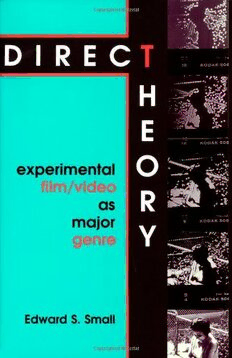
Direct Theory: Experimental Film Video as Major Genre PDF
146 Pages·1994·1.672 MB·English
Most books are stored in the elastic cloud where traffic is expensive. For this reason, we have a limit on daily download.
Preview Direct Theory: Experimental Film Video as Major Genre
Description:
"Art is thinking in images."Victor ShklovskyUndulating water patterns; designs etched directly into exposed film; computer- generated, pulsating, multihued light tapestriesthe visual images that often constitute experimental film and video provide the basis for Edward S. Small’s argument for a new theory defining this often overlooked and misunderstood genre. In a radical revision of film theory incorporating a semiotic system, Small contends that experimental film/video constitutes a mode of theory that bypasses written or spoken words to directly connect Ferdinand de Saussure’s "signifier" and "signified," the image and the viewer. This new theory leads Small to develop a case for the establishment of experimental film/video as a major genre.Small contends that the aesthetic of experimental film/video would best be understood as a coordinate major genre separate from genres such as fictive narrative and documentary. He employs eight experimental technical/structural characteristics to demonstrate this thesis: the autonomy of the artist or a-collaborative construction; economic independence; brevity; an affinity for animation and special effects that embraces video technology and computer graphics; use of the phenomenology of mental imagery, including dreams, reveries, and hallucinations; an avoidance of verbal language as either dialogue or narration; an exploration of nonnarrative structure; and a pronounced reflexivitydrawing the audience’s attention to the art of the film through images rather than through the mediation of words.Along with a theoretical approach, Small provides an overview of the historical development of experimental film as a genre. He covers seven decades beginning in France and Germany in the 1920s with European avant-garde and underground films and ends with a discussion of experimental videos of the 1990s. He highlights certain films and provides a sampling of frames from them to demonstrate the heightened reflexivity when images rather than words are the transmitters: for example, Ralph Steiner’s 1929 H2O, a twelve-minute, wordless, realistic study of water patterns, and Bruce Conner’s 1958 A Movie, which unites his themes of war-weapons-death and sexuality not by narrative digesis but by intellectual montage juxtapositions. Small also examines experimental video productions such as Stephen Beck’s 1977 Video Weavings, which has a simple musical score and abstract images recalling American Indian rugs and tapestries.Small adds classic and contemporary film theory discussions to this historical survey to further develop his direct-theory argument and his presentation of experimental film/video as a separate major genre. He stresses that the function of experimental film/video is "neither to entertain nor persuade but rather to examine the quite omnipresent yet little understood pictos [semiotic symbols] that mark and measure our postmodern milieu."
See more
The list of books you might like
Most books are stored in the elastic cloud where traffic is expensive. For this reason, we have a limit on daily download.
